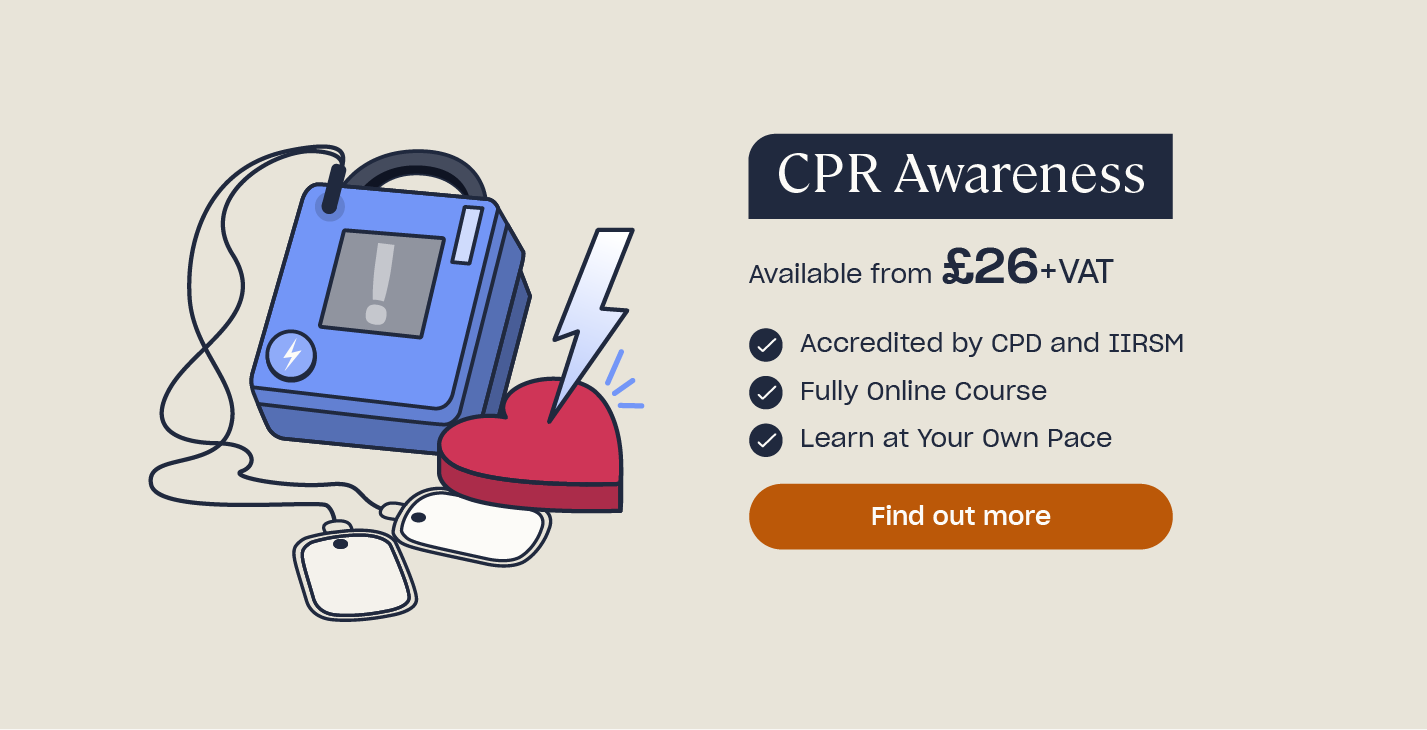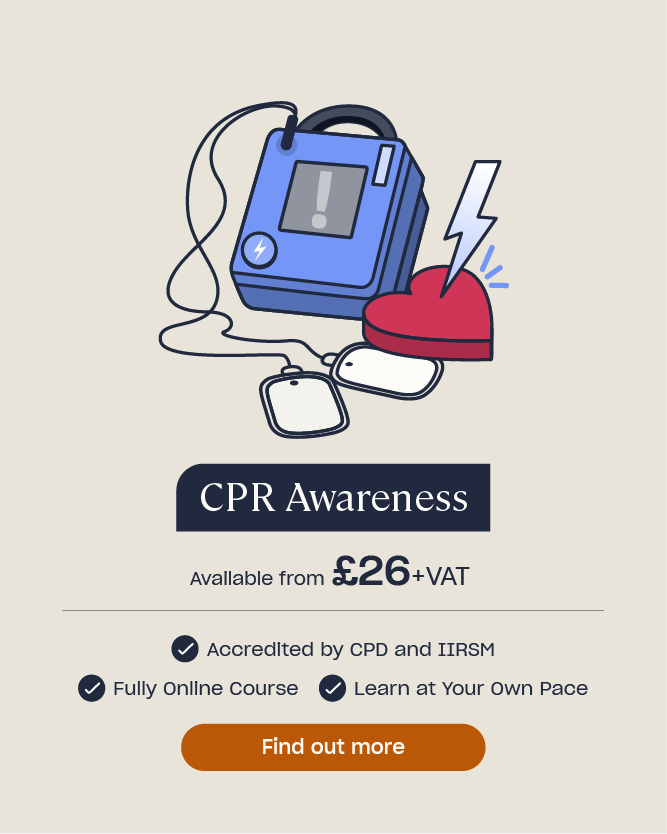How to Administer CPR: Guidelines & Steps
Medical emergencies requiring CPR can happen at any time and place. The British Heart Foundation reports that there are over 30,000 out-of-hospital cardiac arrests a year in the UK. It’s important for everyone to have a basic knowledge of CPR as this may give you the ability to save someone’s life.
In this article, we explain what CPR is, why it is administered and who can give it. You will learn what steps you should take depending on whether you are administering CPR to an infant, child or adult. You will also be able to download the infographics that accompany the stages throughout.
- What is CPR?
- Why Do We Perform CPR?
- Who Can Administer CPR?
- When Do We Use CPR?
- How to Administer CPR on an Infant
- How to Administer CPR on a Child
- How to Administer CPR on an Adult
- How to Administer Hands-Only CPR for Adults
Use the contents above to jump to a certain section of the guide.
What is CPR?
CPR is short for cardiopulmonary resuscitation. It is a life-saving medical procedure that is carried out when someone has a cardiac arrest. A cardiac arrest is where a person’s heart suddenly stops pumping blood around their body. This then starves their brain of oxygen, causing the person to fall unconscious and stop breathing.
A person in cardiac arrest may display the following signs and symptoms:
- Either not breathing or aren’t breathing normally and making gasping sounds.
- Unconscious and aren’t moving.
- Unresponsive, such as to touch or sound.
If a casualty is unresponsive and not breathing normally or at all, it is essential that someone carries out CPR on them immediately.
Know When to Use CPR?
Our CPR Awareness training course will give you an awareness of how to recognise when someone needs CPR and how to administer it. If you want to further develop your first aid awareness, then you could also take a look at our online Workplace First Aid training course and online Paediatric First Aid training course.
Why Do We Perform CPR?
CPR is the manual application of chest compressions and ventilations to a casualty who needs oxygen. Administering CPR helps to circulate blood and oxygen around the person’s body, when their heart and lungs cannot. When giving CPR, you are essentially taking over the role of the casualty’s heart and lungs. This helps to prevent their life-threatening condition from worsening further, before emergency medical assistance arrives and takes over.
A cardiac arrest is a time-sensitive medical emergency. This means that the person’s condition can deteriorate quickly if it isn’t treated as soon as possible. For cardiac arrests that happen outside of hospitals, this means that workplace first aiders, bystanders and family members and friends may be the ones who are present and need to start CPR. In fact, figures by the London Ambulance Service NHS Trust show that around 70 percent of cardiac arrests take place in the home.
Taking action and giving CPR prevents a casualty’s condition from significantly worsening while they wait for emergency medical assistance. For many people, quick intervention may mean the difference between life and death.
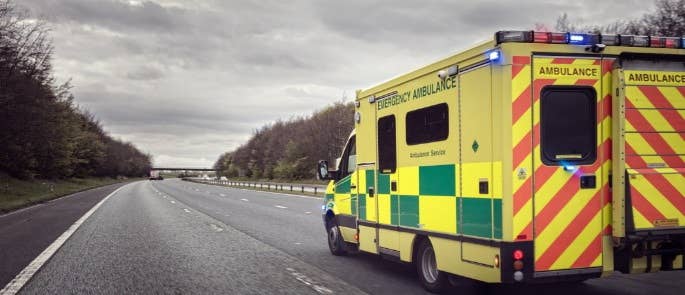
Can Anyone Do CPR?
Before you attempt to administer CPR, you need to be confident in your understanding and be able to recognise when a casualty needs CPR. You must know what steps need to be taken depending on the age of the casualty and whether you have had practical first aid training.
It’s important to note that if you haven’t had practical training that qualifies you as a first aider, you should not give CPR with rescue breaths to adults. This means you should give hands-only CPR (just chest compressions) instead.
However, if a child or infant has a cardiac arrest, it is likely that this is due to a respiratory failure. As a result, you must perform rescue breaths on children and infants if you have had practical training and feel confident in doing so. If you have not had practical first aid training or are uncertain, you must get advice from the emergency services on the best course of action to take for the specific circumstances.
If you have any uncertainties about giving a casualty CPR at any time, you can speak to the emergency call handler on 999 or 112. The call handler is best placed to give you instruction on what to do in various situations.
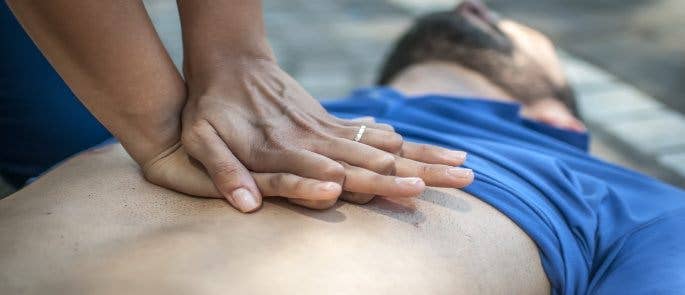
When Do We Use CPR?
CPR should be performed on a casualty if they are unresponsive and not breathing normally (or at all). Someone may be unconscious, unresponsive and not breathing normally due to a number of factors. For example, someone may be drowning and require CPR once they have been rescued from the water. Or, they may be severely choking, severely bleeding, or experiencing shock.
If you find someone who has collapsed and is unresponsive and unconscious, you should carry out a primary survey using the DRABC steps. You can find out more about performing the primary survey in our dedicated article, How to Carry Out the Primary Survey Using the DRABC Steps.
During the primary survey, you should check whether a casualty is breathing by placing your cheek above their mouth. You should listen and feel for their breath and look for regular chest movements for 10 seconds. If they are unconscious, but breathing normally, you should place them into the recovery position. If they are unconscious and not breathing normally, you must prepare to give them CPR.
How to Administer CPR on an Infant
An infant is regarded as under the age of one year old. If an infant has a cardiac arrest, it is likely that this is due to a respiratory failure. As a result, you must perform rescue breaths if you have had practical training and feel confident in doing so. If you have not had practical first aid training or are uncertain, you must get advice from the emergency services on the best course of action to take for the specific circumstances.
To administer CPR to infants, you should:
- Ensure that the emergency services have been called as soon as possible. If possible, someone else should call the emergency services on 999 or 112. If you are alone, you must firstly give one minute of CPR before calling the emergency services on a speaker phone.
- Place the infant on a flat, firm surface and start CPR. Open their airway by placing one hand on their forehead and gently tilting their head back. Use the fingertips of your other hand to lift their chin.
- Put your lips around the infant’s mouth and nose and blow gently for one second until their chest rises. Remove your mouth and wait for their chest to fall back to normal. Repeat this for a total of five rescue breaths.
- Place two fingertips in the middle of the infant’s chest, pressing down by 4 cm (at least one-third of its depth). If you can’t achieve this depth, use the heel of one hand instead. Administer 30 chest compressions at a rate of 100 to 120 a minute and then give two rescue breaths.
- Repeat the sequence of 30 compressions and two rescue breaths until emergency help arrives or the infant starts to breathe normally.
If the infant becomes responsive at any time, such as breathing normally or making noises, put them in the recovery position. You should continue to monitor their condition as you may need to give CPR again.
It’s important to note that defibrillators (AEDs) should not be used on infants that are less than one year old.
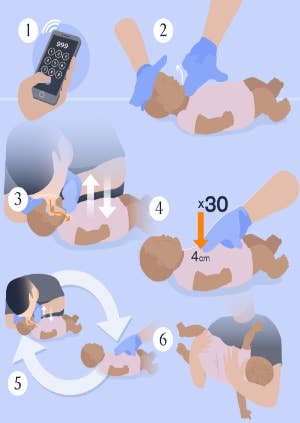
We have created a poster that shows the steps of administering CPR to infants. You may wish to print this out and display it in your workplace as a handy reminder of what to do if an infant is unresponsive and not breathing normally. The CPR steps for infants poster can be downloaded at the link below.
How to Administer CPR on a Child
In first aid terms, a child is anyone from the age of one year old to the onset of puberty (usually around 12 years old). Like with infants, if a child has a cardiac arrest, it is likely due to a respiratory failure. Therefore, you must perform rescue breaths if you have had practical training and feel confident in doing so.
If you have not had practical first aid training or are uncertain, you must get advice from the emergency services on the best course of action to take for the specific circumstances.
To administer CPR to children, you should:
- Ensure that the emergency services have been called as soon as possible. If possible, someone else should call the emergency services on 999 or 112. If you are alone, you must firstly give one minute of CPR before calling the emergency services on a speaker phone.
- Start CPR by laying them down. Gently open their airway by placing one of your hands on their forehead and tilting their head back and using the fingers of your other hand to lift their chin.
- Keeping their head tilted, pinch their nose with the hand that was on their forehead. Place your mouth over theirs and blow for up to one second until their chest rises. Remove your mouth and watch their chest fall. Repeat for a total of five initial rescue breaths.
- Prepare to give 30 chest compressions at a rate of 100 to 120 a minute. Place the heel of one hand on the centre of their chest and push down by 5 cm (one-third of the chest diameter). If you can’t achieve a depth of 5 cm with one hand, use both by interlocking them as you would when giving an adult CPR. Release the pressure and then repeat 30 times. Give two rescue breaths.
- Repeat the sequence of 30 compressions and two rescue breaths until the casualty begins to recover and breathe on their own, until emergency help arrives or a defibrillator is ready to be used.
If the child becomes responsive, you must put them into the recovery position. Continue to monitor their condition while you wait for emergency assistance as you may need to give CPR again.

We have created a poster that shows the steps of administering CPR to children. The CPR steps for children poster can be downloaded at the link below.
How to Administer CPR on an Adult
In first aid terms, an adult is anyone from the onset of puberty (usually around 12 years old) and older. If you are a qualified first aider, meaning you have previously attended a practical and certified training course, and feel confident in using your skills, then you should give the adult casualty rescue breaths with the chest compressions.
To administer CPR to adults, you should:
- Ensure that the emergency services have been called immediately. Someone who isn’t going to be performing CPR should do this, or you should put the emergency services on speaker phone to talk to them while you give CPR. If someone else is nearby, you should ask them to fetch a defibrillator if available. Do not go looking for one yourself, as your priority is to give CPR.
- Kneel next to the casualty and position them on their back.
- Straighten your arms and lean over the casualty, placing the heel of one of your hands on the breastbone at the centre of their chest. Place the heel of your second hand on top of the first, interlocking your fingers and making sure they don’t touch their ribs.
- Keep your arms straight and use your body weight to press directly down to a depth of 5 to 6 cm. Release the pressure and allow the chest to rise back up. Repeat this 30 times at a rate of two per second, or in time with the song ‘Staying Alive’.
- Give two rescue breaths after the 30 chest compressions. To do so, tilt the casualty’s head and gently lift up their chin with two fingers. Pinch their nose, take a deep breath and seal your lips around their mouth. Blow deeply for about one second until you see their chest rise, remove your mouth and let the chest fall. Repeat once more so they receive a total of two rescue breaths.
- Continue this process of 30 compressions followed by two rescue breaths until the emergency services arrive, the casualty starts breathing on their own, you become too exhausted to continue or if a defibrillator is ready.
If the casualty starts to breathe normally, you should put them into the recovery position. Continue to monitor their condition while you wait for the emergency services to arrive as you may need to give CPR again.
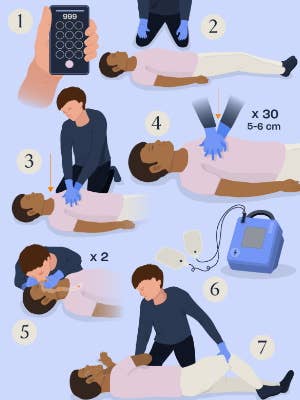
We have created a simple infographic that shows the steps of administering CPR with rescue breaths to adults. The CPR steps for adults infographic can be downloaded at the link below.
How to Administer Hands-Only CPR for Adults
If you aren’t a qualified first aider and haven’t had practical training, you should not give rescue breaths to adults during CPR. Instead, the NHS advises that you should only attempt the chest compressions.
You should still give rescue breaths to children and infants though during CPR, provided you’ve had the necessary practical training and feel confident.

To administer hands-only CPR to adults, you should:
- Immediately ask someone to call 999 or 112 while you start CPR. If you are alone, you should call for emergency help yourself and put the phone on speaker mode to allow you to start CPR at the same time. If someone else is nearby, you should ask them to fetch a defibrillator if available. Do not go looking for one yourself, as your priority is to give CPR.
- Start CPR by kneeling next to the casualty’s chest and positioning them on their back.
- Straighten your arms and lean over the casualty, placing the heel of one of your hands on the breastbone at the centre of their chest. Place the heel of your second hand on top of the first, interlocking your fingers and making sure they don’t touch their ribs.
- Keep your arms straight and use your body weight to press directly down to a depth of 5 to 6 cm. Release the pressure and allow the chest to rise back up. Give continuous compressions at a rate of two per second, or in time with the song ‘Staying Alive’.
- Repeat compressions at a rate of 100 to 120 times a minute until the emergency services arrive, the casualty starts breathing on their own, you become too exhausted to continue or if a defibrillator is ready to be used. If you do become too exhausted to continue and there is another person present, they may be able to take over with chest compressions while you rest. You can then change every couple of minutes, taking it in turns to give hands-only CPR to the casualty.
If the casualty starts to breathe normally, you should put them into the recovery position. Continue to monitor their condition while you wait for the emergency services to arrive as you may need to give CPR again.
Ensuring that someone who is unresponsive and not breathing normally is given CPR as soon as possible increases their chances of survival before the emergency services arrive. Therefore, it’s important for everyone to have an awareness of how to administer CPR, whether they are a qualified first aider or not. Although non-qualified first aiders should only give hands-only CPR to adults, and seek the advice of the call handler when giving CPR to children and infants, doing so will still increase the chances of the casualty surviving.
Further Resources:
- Workplace First Aid Training
- What are the Responsibilities of a First Aider?
- Guidance for First Aid Kits in the Workplace
- Paediatric First Aid Quiz
- Guidance on What To Do If Someone Is Choking
- CPR Awareness Training


